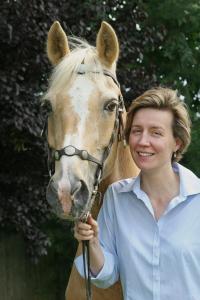Quick Links
IEOC Members Reflect
My Journey into Equine Ophthalmology
 by Noelle La Croix, DVM, DACVO
by Noelle La Croix, DVM, DACVO
I am a city girl raised in a borough of New York City hardly famous for its ball team (Mets fans are fond of saying "Wait till next year!") but it does host one of the most popular horse races in the world. However, my urban roots confined my initial exposure to horses to pony rides, Central Park carriages, and the wonders of carousels. In retrospect, I grew up within a few miles of Belmont Park (where one part of the famous Triple Crown is run). But alas, my parents did not gamble. Like most young girls I surely dreamed of owning a pony one day. But as a middle class NYC resident, this was a financial impossibility.
By the time I started veterinary school my attraction to horses was akin to my attraction for all sapient and sentient creatures that we share our journey of life with. I guess I could blame my mother for this as she had continually adopted stray cats from the neighborhood. Our home was always filled with the love of furry companions.
Starting at Tufts Veterinary, I met some extraordinary individuals who shaped my future career. The first was Philip Anthony Moore at Tufts. Anthony was the only ophthalmologist at Tufts in those days and he was busy studying for the ACVO boards. Slammed with clients for 14 hours a day, and beleaguered with studying, he still made time to answer my questions and help with my patients. Anthony carted me along to horse cases in the field and even to the Boston Aquarium (penguin cataracts and electric eel eye surgery...Wow!). Anthony included me in his world and I was thrilled.
During my third year at Tufts, summer rotations brought me into contact with the equally wonderful Alexandra (Sandra) van der Woerdt of the Animal Medical Center (AMC) back in NYC. Fortuitously, ophthalmology was the only department that could schedule my rotation as I would also be spending that summer as an equine technician at Tufts. Sandra showed me just how much fun ophthalmology could be while optimizing the care of her patients and respecting her clients' needs.
After veterinary school, and an internship at the AMC, I continued working in the NYC area with John Sapienza. I accompanied him on barn calls on Long Island and I watched his equine surgeries at a hospital at Belmont Park. After this exposure to these caring and intelligent professionals I knew that I wanted to join their club as an ophthalmologist.
My ophthalmology residency began in Arizona with Eye Care for Animals. Horses were finally regular customers. Reuben Merideth loved examining horses with me even if it meant long unprofitable journeys to see them. I quickly learned from Reuben that horses are not big dogs - which was awfully important information for this city-trained vet. I also tagged along with Ed Voss (an ACVIM diplomate at Arizona Equine) for more useful exposure to these magnificent creatures. Ed taught me that good equine practitioners recognize and treat ocular disease out in the field where ophthalmologists may be scarce. Ed helped me recognize the linkage of ocular conditions with systemic disease. Feeling sorry for the city girl, Ed also let me in on some important trade secrets such as the differences between horses, donkeys, and mules!
I finally meandered my way back to NYC as an ACVO diplomate. My practice on Long Island now sees a good number of horses with owners of diverse financial backgrounds each year. Unfortunately, there are also a few hundred abandoned horses on Long Island. Most of these animals were abandoned due to the finances associated with their healthcare. It has been estimated that about 10% were abandoned because of ocular disease (chronic uveitis, inoperable squamous cell carcinoma, blinding injuries, etc.). I volunteer with a non-profit organization (Amaryllis Farm Equine Rescue) dedicated to helping these animals. This is a particularly rewarding part of my career as I can provide some level of comfort to, and possibly prolong the vision of, these horses.
Belmont Park has also finally become a part of my ophthalmic career. The newly established Cornell Ruffian Equine Specialists offers specialized 24-hour hospitalization on Long Island and it is conveniently located next to some of the most valuable horses in the world. I have performed surgery at this hospital and I am extremely satisfied with the staff's level of compassion and professionalism. I predict that this facility will become a world-class establishment for equine health just a few miles from my humble beginnings.
I would also like to use this space to acknowledge my joy and enthusiasm for the IEOC. Being part of this group has helped me to become a better equine ophthalmologist for my clients. On a personal level, the best parts of IEOC are the friendships with other similarly-minded practitioners who have been nurtured by this organization. I can't help but appreciate individuals like Dennis Brooks who value honesty above ego especially when discussing success rates and complications. Andy Mathews brings insatiable curiosity and value for the history of our field (and history in general) to every meeting. There are numerous others that continue to guide, teach, and support me at IEOC. These include Tim Cutler, Ann Dwyer, Tim Knott, Edith Hampson, Maria Kalberg, Kohle Herrmann, Amber Labelle, Bill Miller, Caryn Plummer, Gil Ben-Shlomo, and Mary Utter to name just a few. I hope we can all continue this journey in equine ophthalmology together.
